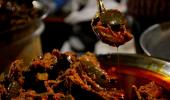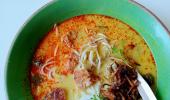
It was turmeric that finally led me to start going organic.
When I heard from my physician sister, who is always researching food, that turmeric can have high arsenic content, I changed over to organic turmeric.
The search for organic food is an escalator and once you step on it, you slowly begin to look for more and more organic products and fresher, nearer and kinder produce.
Why not choose wholesome organic rice, especially the beneficial varieties like Manipur's chak khao or black rice or Kerala matta rice, I thought? And free-range eggs sold by Farm Made, where chickens live on a large estate in Tamil Nadu? Wouldn't wood cold-pressed mustard and peanut oil be a better alternative?
Organic red chilly powder cannot have red colour in it and must be worth a buy? Should I not be on the lookout for freshly-crushed hing or asafoetida for more taste? Or find hadsaticha tandool or locally-pounded rice, like my colleague Mayur suggested?
When I was growing up you had to go to a special store to get organic food, like you were shopping for something as different as pet food, and organic food customers were these hippy-ish, let-it-all-hang-out folks, sporting long hair, carrying tins of tiger nut milk and brewer's yeast under their arms.
Today organic food is a higher, enlightened lifestyle, with countries like Denmark and Switzerland leading the world in per capita consumption. In India, in Sikkim, farming has gone all organic, and Uttarakhand and Tripura are following in its footsteps, and Australia, India (4.73 million hectares) and Argentina, top the world, as per 2022 Statista data, in organic farming acreage.
In India, particularly, there is nowadays no shortage of organic ingredients to be had, including milk, and the range is actually quite astounding -- all kinds of less polished, less de-husked, indigenous, village industry foodstuff. Just search online for organic groceries or check Amazon for their organic range.
Many a brand, even smaller farm-to-fork ones, have their own sites, selling everything from cottage industry or organic jams, lemon curd, yoghurt to cheese, ghee, paneer. One gets to hear about organic food sources by word of mouth too -- for instance, my colleague Ronjita has been for years buying organic fruits, vegetables and milk from a small local farm source.
We don't have solid guarantees about some of their authenticities, so we must hope for the best, and adopt them in good faith. It also pinches the pocket a bit, especially when you switch over to organic rice and dals and oil.
Organic groceries are considered beneficial because, according to the Mayo Clinic Web site, they potentially have more nutrients, less pesticides, less non-natural fertilisers, less chemicals, less hormones, no genetic engineering.
It's important to read the labels carefully and assess the brand, going a bit on gut feeling -- some Indian organic products are even USDA approved with a United States Department of Agriculture certification.
Going organic or going back to how farming/harvesting was once done, is also a bid to look for better ingredients and plant alternatives too. Healthier stuff and more varied as well.
Edamame is one such food. Immature soybeans, it is easily a top nutritious legume. And wow is it tasty too!
Packed with protein, but not much fat, it also contains fibre, vitamin K, folate, iron, calcium, vitamin A, vitamin C, manganese, according to WebMD. And the fat it owns is the valuable omega-3 and omega-6 fatty acids. To give you perspective, one serving of edamame ie half a cup, has as much iron a 115 gm serving of chicken breast.
Edamame is these days available fresh, frozen or dried. Since I am on a fresh, fresh, fresh mission, I succeeded in sourcing some recently harvested edamame from Trikaya online, who delivered it to my door.
And Edamame Truffle Rice just had to get made!
The truffle part is not so easy to come up with. It's expensive and you need a lot to add enough flavour. I had some truffle oil gifted from a friend who went to Italy. It is available, locally but make sure you opt for a reliable brand and store in the fridge; it lasts well.

Edamame Truffle Rice
Serves: 2-3
Ingredients
- 1½ cups uncooked basmati rice
- 2 cups water
- 1 tsp butter
- 100 gm mushrooms, very finely chopped
- 1 tbsp extra virgin olive oil + extra for frying the mushrooms and the ginger
- 7-8 pods garlic, crushed or minced
- 2-3 stalks spring onions, whites and greens chopped separately
- 100 gm baby corn, very finely chopped
- Salt to taste, about 1½ tsp
- 1 tsp Tabasco
- 2 tbsp truffle oil
- 200 gm shelled fresh or frozen edamame
- 4-inch piece ginger, finely chopped
Method
- Cook the 1½ cups basmati rice in 2 cups water, over low heat, till the water is absorbed and the rice is cooked, growing nice long grains.
Add the butter and fluff up and toss the rice with a fork.
Keep aside. - In a frying pan over medium, fry the chopped mushroom with a little olive oil, till mostly cooked.
Drain from the frying pan and pat off any extra oil.
Keep aside. - Fry the ginger till red and crisp.
Drain onto a tissue or paper towel-lined plate.
Keep aside. - Fry the minced garlic and the whites of the spring onions in olive oil, over medium heat, in a wok or kadhai or large saucepan, for 1-2 minutes.
Add in the cooked rice, salt, Tabasco, baby corn, fried mushrooms, edamame, fried ginger and keep cooking over medium heat till the baby corn is cooked, about 5-6 minutes.
Add in the truffle oil and the greens of the spring onions and take off heat. - Serve with salad, soup, or like I did with boiled potatoes with corn or baked bean toppings.
Zelda's Note: Instead of basmati rice, try black rice or unpolished indrayani.
Vegetable additions can vary according to your taste. Asparagus or broccoli can taste just as good as baby corn. But keep the mushroom in, because that boosts the umami taste that the truffle oil also provides.
You could also add scrambled eggs.










